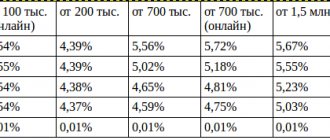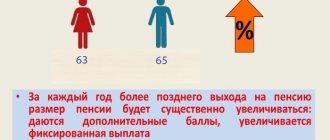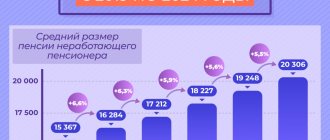The problem of the aging of the nation is relevant for Russia. Since 2010, the country has seen a decrease in the number of citizens who are of working age. According to the 2010 census, almost 19% of the country's population were citizens aged 60 years.
If the current growth rate is taken as an absolute value, then by 2030 the share of the population aged 65 alone will be almost 1/3 - 28%. And according to the UN, by 2050 the most economically active part of the population, which is between the ages of 20 and 60, will practically not exceed half of society.
OTHER USEFUL MATERIALS:
- Rating of Russian regions by life expectancy
- Comparison of pension size and retirement age in Russia and in different countries of the world
Currently, the number of pensioners in the country is growing rapidly without being replaced by an equivalent number of able-bodied citizens. Many experts believe that the only effective method to change the current situation is to increase the retirement age of working citizens, which was done in the new law on pensions
Infographics: “The number of pensioners in Russia in different years”
The retirement age will increase gradually. Increasing the retirement age, as a method to improve the situation with the aging of the nation, is used by many European countries. But, given the high standard of living in Europe, the much smaller population, the size of the territories, different from Russian ones, this measure, even if it brings benefits, will take a very long time.
An important factor aggravating the situation is that the labor market for pensioners is not developed in Russia. In addition, many employers are trying to get rid of workers of retirement age. Not realizing that they are increasing the number of unemployed qualified personnel and placing an additional burden on the working population.
Forecasts and reality about the number of pensioners
According to the latest data from the Pension Fund, in 2021 the total number of pensioners in Russia reaches 46.2 million people . Of these, the majority receive an old-age insurance pension, and another part receive a social pension. The rest are recipients of pensions for disability, loss of a breadwinner and victims of disasters.
Earlier, former head of the Pension Fund of Russia Anton Drozdov stated that due to changes in the retirement age, the number of pensioners in 2021 would decrease by 800,000 people. Let us remind you: today citizens aged 55.5 and 60.5 years will be able to retire.
Number of working and non-working pensioners in the Russian Federation
The increase in the number of non-working pensioners greatly increases the tax burden on working people. This factor undermines the well-being of existing pensioners, and an obvious indicator of this is that the pension fund budget is weakening. As a result, there is no possibility of indexation of pension benefits and it is expected to lag behind the inflation rate.
During 2015, the number of pensioners in Russia increased by more than 600,000 people.
The figure significantly exceeded the 2014 data. This is explained by the fact that from January 1, 2015, pensioners of the Republic of Crimea and a city with federal status, Sevastopol, joined Russia’s pension funds.
The number of recipients of the insurance part of pension payments under the new law during 2015 increased by almost 500,000 people and at the beginning of 2021 amounted to more than 42.7 million people. In 2021, an increase of more than half a million pensioners is expected.
In 2021, the number of pensioners increased to almost 43 million people. Thus, their share amounted to a third of the Russian population.
As of January 1, 2021, the number of working pensioners is 9.3 million . They make up 21.4 percent of their total number. In the same period in 2021, the figure was 9.6 million.
Thus, the percentage of non-working pensioners in Russia (including disabled people and those receiving survivor benefits) is slightly less than 80 percent. This is evidenced by official data, but how things really stand is known only to the pensioners themselves and their employers involved in the shadow sector.
For example, after a moratorium was imposed on the indexation of pensions for working pensioners, almost half of them ceased to be officially employed. For comparison: as of 2016, the number of working pensioners was 15.2 million people, and a year later, in 2017, it was 9.8 million.
Number of pensioners in some regions in 2021:
- Most pensioners live in the capital - 2,669,966;
- Moscow region - 1,878,776;
- Krasnodar region - 1 469166;
- Novosibirsk - 800 100;
- Rostov-on-Don - 1,100,000;
- Kazan - 1,106,900.
These figures do not include the number of military retirees, since their retirement is carried out by the military department. The category of military pensioners of the Ministry of Defense includes military personnel who have 20 or more years of experience in the Armed Forces, disabled people from military service and those who receive a military pension for the loss of a breadwinner.
The number of military pensioners in 2021 exceeded the regular composition of the modern Armed Forces. It is difficult to talk about the exact ratio of retirees and active military personnel, because there is a constant movement of personnel in the army: conscription, retirement, and the annual arrival of new personnel from military schools.
According to today's statistics, the supply of fresh personnel is stable or more than in previous years. But those who apply for pension benefits are approximately 1.5 times less than military pensioners. The growth in the number of pensioners in the army is much lower than in the civilian world, but, nevertheless, it is present.
According to forecasts, by 2030 the growth in the number of military pensioners should stabilize and stop at 700,000 people, which should account for 1/3 of the active military in the Armed Forces.
It is planned that stabilization will be facilitated by the increased attention of the state to increasing the amount of pay for military personnel, which will attract more young people to the ranks of the Russian army, the Ministry of Internal Affairs, the Ministry of Emergency Situations and other law enforcement agencies.
As for the situation with the population of retirement age, by 2021 the labor market is expected to suffer from the fact that the birth rate fell sharply in the 90s, that is, a decrease in the number of working-age population in Russia by 10%. It is also predicted that the number of 80-year-old citizens will double and a significant increase in pensioners born in 1960–1965.
Dynamics of the number of pensioners from 2012 to the present
| Year | Total number of pensioners, million people. | Receiving old-age insurance pensions, million people. | Receiving social pensions, million people |
| 2012 | 40.2 | 32.9 | 2.8 |
| 2013 | 42.8 | 33.4 | 2.9 |
| 2014 | 43.3 | 33.9 | 2.9 |
| 2015 | 43.8 | 34.4 | 3 |
| 2016 | 45.2 | 35.5 | 3.1 |
| 2017 | 45.7 | 36 | 3.1 |
| 2018 | 46.1 | 36.3 | 3.1 |
| 2019 | 46.5 | 36.7 | 3.2 |
| 2020 | 46.2 | 36.3 | 3.2 |
Detailed number of pensioners in Russia in 2015-2016.
| 2015 | 2016 | |
| Number of pensioners registered with the Pension Fund | 41456000 | 42 729 00 |
| Including: | ||
| By old age | 34422000 | 35555000 |
| Disabilities | 2317000 | 2267000 |
| Survivor loss | 1331000 | 1395000 |
| Victims of radiation disasters | 312000 | 332000 |
| Civil servants | 66000 | 71000 |
| Social | 3007000 | 3108000 |
| Working pensioners | 14917000 | 15259000 |
| Including: | ||
| By old age | 13872000 | 14199000 |
| Disabled people | 773000 | 759000 |
| Survivor loss | 17000 | 23000 |
| Victims of radiation disasters | 118000 | 127000 |
| Civil servants | 20000 | 22000 |
| Social | 116000 | 128000 |
The years take their toll
Photo: istockphoto.com
“Increasing the retirement age objectively increases the supply of labor over the age of 55 for women and 60 for men,” says Alexander Safonov, a professor at the Financial University under the Government of the Russian Federation. — At the first stage, this is not a very high figure, since presidential benefits for early retirement apply in the first two years (at 55.5 and 56.5 years, 60.5 and 61.5 years). But already now maintaining employment is important for more than 500 thousand people.”
According to Safonov, only 5-7% of people after retirement can ensure a comfortable old age without continuing to work. At the same time, not every older person who wants to continue their career after retirement has the opportunity to realize their desire. And there are objective reasons for this, including a general decline in the number of jobs; reduction in the number of vacancies in traditional industries associated with mass employment; decreased demand for labor from large and medium-sized enterprises.
Mature people themselves say that the main problem in finding employment is giving priority to young professionals (this is the opinion of 51% of participants in a study conducted by the Academy of Labor and Social Relations). In second place is the lack of jobs (20%), in third is the lack of vacancies in the specialty that a person has (13%).
The main problem in employing older people is priority for young specialists
“Of course, there is a ban on refusing to hire based on age. But for now this norm is dormant, since it is almost impossible to prove the fact of age discrimination to the plaintiff,” states Safonov. This is in contrast to European countries, where in civil proceedings the burden of proof of the absence of age discrimination falls on the employer. This experience could be adopted, the expert believes.
In addition, it is worth introducing a mandatory consideration of the reasons for the dismissal of older workers in a special manner. For example, in agreement with the labor council, trade union organization or within the framework of a tripartite commission on social partnership at the municipal level. If the reason for dismissal is a lack of qualifications, then such workers should be sent at the expense of the budget for additional training according to a program agreed with the employer, the expert continues.
Safonov also proposes forming groups of expert advisors from among older workers. “To do this, it would be possible to make appropriate changes to the laws on civil service and state civil service,” he says.
In any case, additional training for older workers should not be part of a program to promote employment for people under threat of dismissal, but rather a renovation of the professional qualifications of older generations. Training should take place constantly and in the system of secondary vocational and higher education.
Today, 72 percent of pensioners continue to work because of low pensions, 22 percent because of the need to support other family members. 14 percent each fall on those for whom it is important to maintain social status and interest in the profession. Due to the convenient location of work and the desire to avoid loneliness, 13 and 12 percent of pensioners, respectively, work.
How many WWII veterans are alive in Russia?
As of January 1, 2021, there are 134,735 registered Great Patriotic War Veterans in Russia who receive monthly cash payments.
These include participants of the Second World War, including:
- persons who did not serve in military service outside the active army (58,777);
- persons who served in military service outside the active army (1992);
- persons awarded the badge “Resident of besieged Leningrad” (73888);
- persons working at defensive facilities and crew members of transport fleet vessels (78).
The table below shows how the number of participants in the Great Patriotic War has changed since 2013:
| Year | Total number of WWII veterans, people. |
| 2013 | 245014 |
| 2014 | 226366 |
| 2015 | 210366 |
| 2016 | 194767 |
| 2017 | 178817 |
| 2018 | 163510 |
| 2019 | 149280 |
| 2020 | 134735 |
The largest number of WWII veterans live in the United States of America - almost 430 thousand people.
Number of pensioners in Moscow and constituent entities of the Russian Federation
According to statistics provided by Rosstat, 32.3 million pensioners live in cities, and another 11.2 million live in rural areas.
There are 3.2 million pensioners living in Moscow, of which 2.7 million receive old-age pensions, 139 thousand receive social pensions. There are 2.1 million registered pensioners in the Moscow region. 1.8 million of them receive an old-age pension, and 101 thousand people receive a social pension.
The table below shows the number of pensioners in the Federal Districts.
| Name of the federal district | Total number of pensioners, million people. |
| Central Federal District | 11.5 |
| Northwestern Federal District | 4.2 |
| Southern Federal District | 4.8 |
| North Caucasus Federal District | 2.5 |
| Volga Federal District | 9.1 |
| Ural Federal District | 3.7 |
| Siberian Federal District | 5.6 |
| Far Eastern Federal District | 1.8 |
Current figures for 2021
According to Rosstat, 43 million 865 thousand people receive pensions in Russia. But this figure must be treated with caution. The word “pensioner” in the public consciousness often has a completely different meaning than what Rosstat intends.
Figure 1. Disability payments are also included in statistics
According to the department’s methodology, pensioners are citizens who are registered with the Russian pension fund. Two important consequences follow from this definition:
- citizens receiving pensions from the budget of the Ministry of Internal Affairs and the Ministry of Defense are not taken into account in statistics;
- the figure includes citizens receiving disability payments, survivor benefits and other types of financial assistance.
The table provides detailed data for each type of social benefits. 36 million 710 thousand people receive old-age pensions in Russia – about 25% of the country’s population.
Table 1. Number of citizens receiving pensions from the Pension Fund
| Category | Number of people, thousand people |
| Pensioners registered with the Pension Fund of Russia | 43865 |
| - old age | 36 710 |
| – on disability | 2 043 |
| - loss of a breadwinner | 1 403 |
| – victims of man-made disasters | 443 |
| – social | 3 188 |
| – other | 78 |
Source: Rosstat
The number of working old-age pensioners exceeds 8.5 million people. Statistics on disabled people reveal a similar picture: 652 thousand people continue to work.
Good to know : benefits for working pensioners
Payments to former police officers and members of the Russian army are accounted for separately. Pensions for these categories of citizens come from the budgets of the Ministry of Internal Affairs and the Ministry of Defense. The Russian Pension Fund does not receive contributions from military personnel and police, but does not pay them old-age benefits either. The only exceptions are those who managed to accumulate “civilian” experience after finishing their service in the Ministry of Internal Affairs or the armed forces.
Figure 2. Payments to law enforcement officers and army officers are not included in the Pension Fund statistics
According to the latest data, the number of military pensioners in Russia is 1.11 million people. Another 1.05 million people receive pensions through the Ministry of Internal Affairs. In total, 46 million people receive pensions in Russia. This is 31.8% of the country's population.
Number of pensioners in other countries of the world
According to public data from the United Nations Population Division, there are more than 70 million people aged 60 years and older in Africa, more than 600 million in Asia, more than 190 million in Europe and more than 160 million in South and North Africa. America.
China is considered to be the most populated country in the world. The Celestial Empire is home to 1.4 billion people, among whom more than 120 million are pensioners.
There are 43.7 million citizens over the age of 64 living in the United States.
As for the countries of the former Soviet Union (now the CIS), the largest number of citizens 60-65 years old live in Russia (48,525 thousand), followed by Uzbekistan with an indicator of 1,512 thousand, then Belarus (1,339 thousand), Kazakhstan (1,407 thousand), Azerbaijan (668 thousand), Moldova (421 thousand), Kyrgyzstan (341 thousand), Tajikistan (321 thousand) and Armenia (307 thousand).








